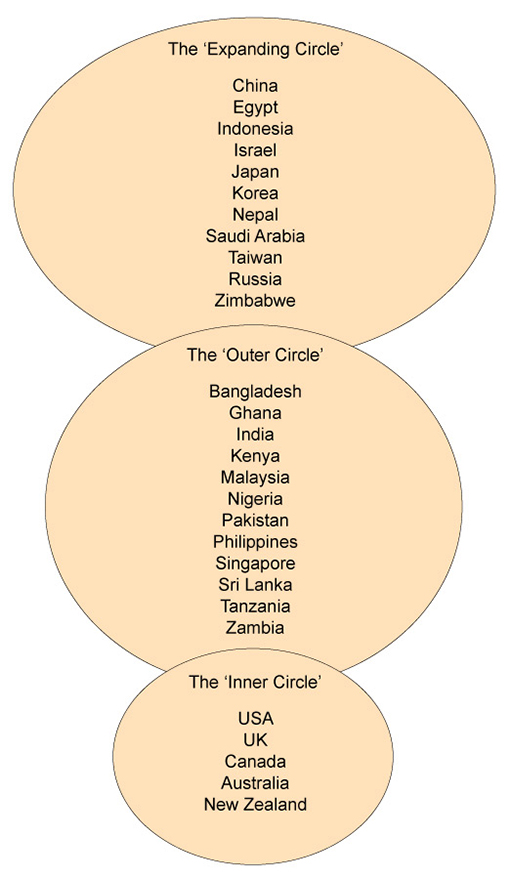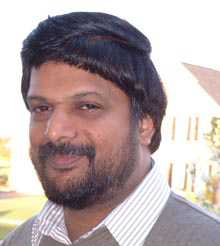9 English as a global language and World Englishes
Another challenge to established paradigms prompted by globalisation and increased transnational and translingual communication can be found in the field of global English. Here, it is argued that because the number of English speakers has grown so considerably in recent decades, with estimates suggesting that non-native speakers of English now outnumber native speakers by at least three to one, new ways of thinking about norms and ownership are needed. One paradigm that has subsequently attracted criticism is Kachru’s three-circle model of English speakers (Kachru, 1992). When it appeared, this was itself a groundbreaking way of thinking the English language and stimulated a wealth of research under the heading ‘World Englishes’.
The field of ‘World Englishes’ developed towards the end of the twentieth century with the work of Braj Kachru and others to theoretically and empirically investigate the statuses and functions of the English language in various contexts around the world, and explore issues in the ownership of English. Kachru’s (1992) well-known three-circle model of English speakers has become an influential way of understanding the varieties and functions of different Englishes being used in the world. This can be broken down as follows:
- The inner circle (norm providing) represents the traditional sources of English speaking, e.g. UK, USA, which have provided the language norms for English Language Teaching (ELT).
- The outer circle (norm developing) which includes countries in Africa and Asia, where English is not necessarily people’s first language but has been important historically through colonisation.
- The expanding circle of countries (norm dependent) where English has never had an official status, but is now important as an additional language or lingua franca.
The field of ‘World Englishes’ broke new ground in terms of challenging conventional notions of language ownership, and there is now a considerable literature on the existence of national or regional varieties of English, e.g. Indian English, Nigerian English, Malaysian English, Singapore English and so on. However, in response to the continued global spread of English, as well as the increasing diversity among communities within nation states as a result of globalisation, there have been criticisms launched against this work. In the following interview, Suresh Canagarajah questions whether Kachru’s model – which was developed at the end of the twentieth century – is still useful in the context of the twenty-first century.
Activity 3
Transcript: Suresh Canagarajah
Part 1
Listen to the audio interview with Suresh Canagarajah, conducted by one of the course authors. As you listen, consider what changes in the use of English across the world are calling into question Kachru’s tripartite model. Note them down in the text box.
Discussion
English is now spoken more extensively outside the inner circle, as an additional language. It is used globally in youth culture, and countries in the expanding circle are evolving their own norms and claiming English as one of their local languages. The norm-providing role of the inner circle and the status of ‘native speaker’ are therefore being questioned. Canagarajah suggests the use of the term ‘plurilingual English’ to better describe this context in which norms of English are not stable.
Part 2
How does Canagarajah suggest replacing the concepts underpinning ELT listed in the following table?
| Original term | New term |
|---|---|
| target language | |
| linguistic proficiency | |
| grammar | |
| native speaker norms | |
| language competence | |
| language as a system | |
| individual stable languages |
Discussion
Canagarajah suggests replacing terms as follows:
| Original term | New term |
|---|---|
| target language | language repertoire |
| linguistic proficiency | language awareness |
| grammar | negotiation strategies |
| native speaker norms | intersubjective norms negotiated on the spot by multilinguals |
| language competence | social competence |
| language as a system | language as a process |
| individual stable languages | languages as fluid, interactive, mixed |
The criticisms charged at established theories of learning and language have been prompted by real-world changes such as migration and globalisation and a resultant increase of bi- and multilingualism and increase in the number of English-language users. Educational practitioners are still working on how to implement these changes into their practices. Some of the question which still need to be addressed are: according to what norms should English language learners be taught if non-native speakers outnumber native speakers? How does one reorient curricula and teaching strategies to align with the new terms suggested by Canagarajah above? To what extent do learners want and need to be taught according to more established norms and are we doing them a disservice by ignoring the status and prestige of established norms and varieties? The answers to such questions are complicated and are likely to emerge over time.


